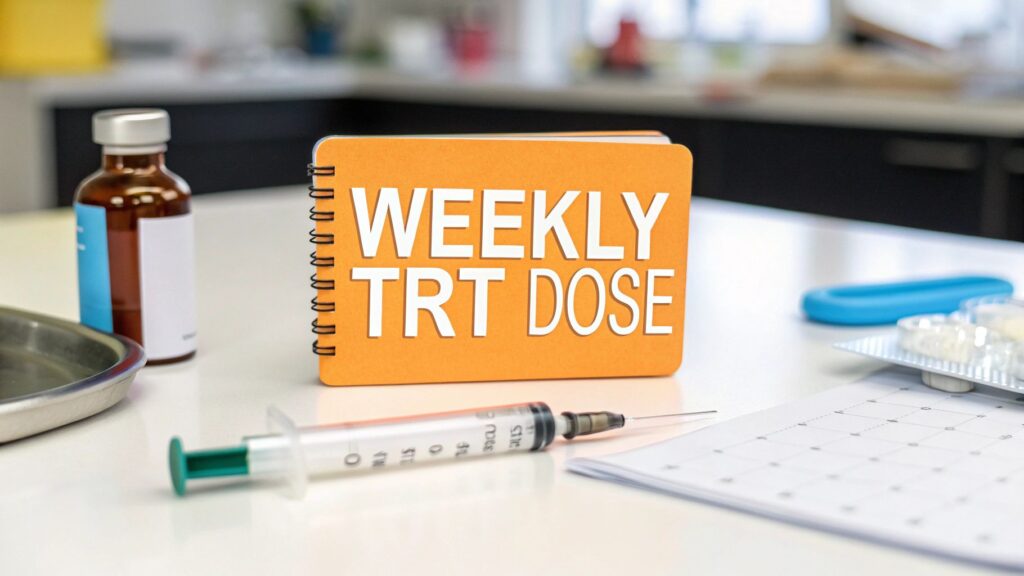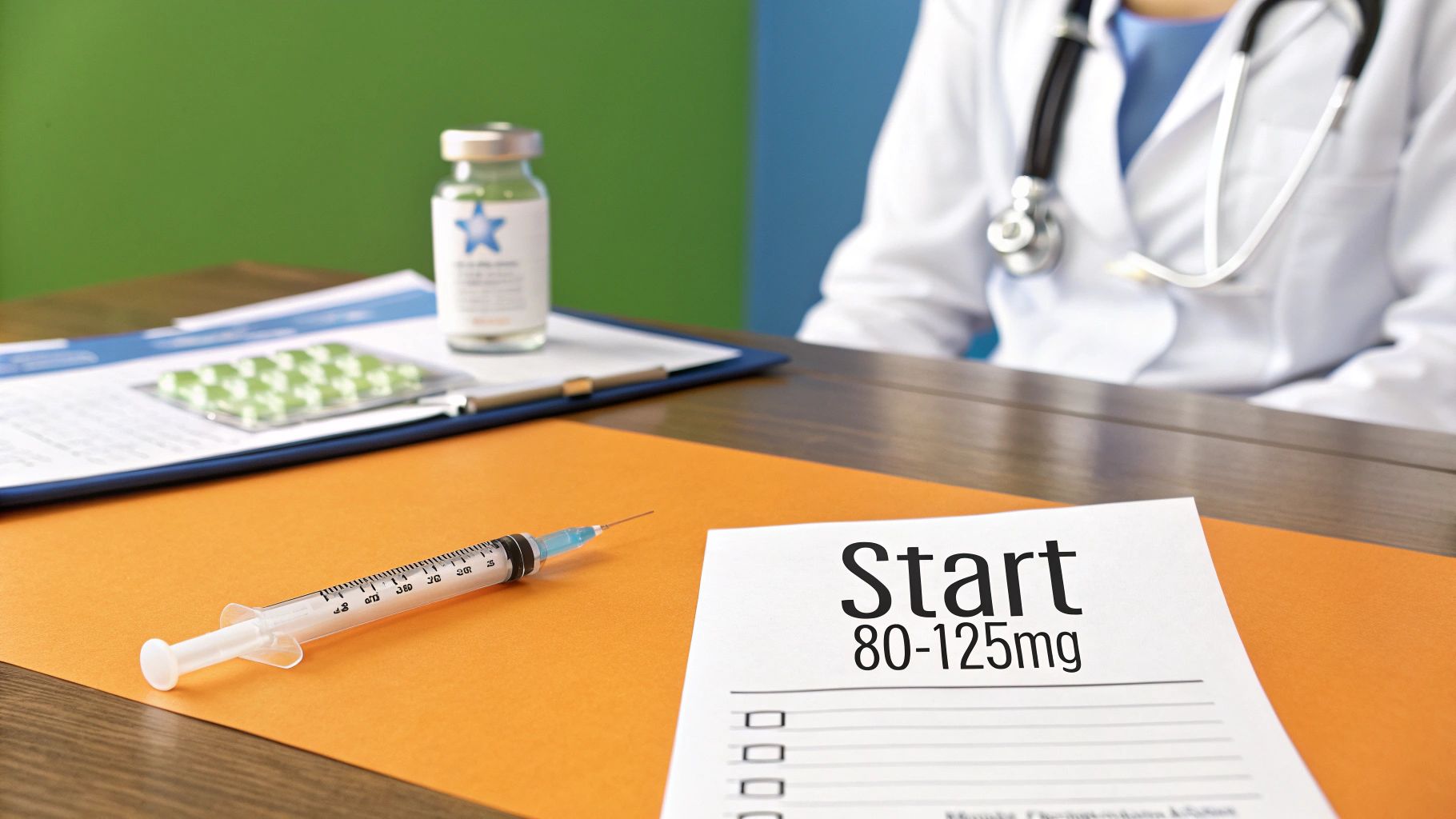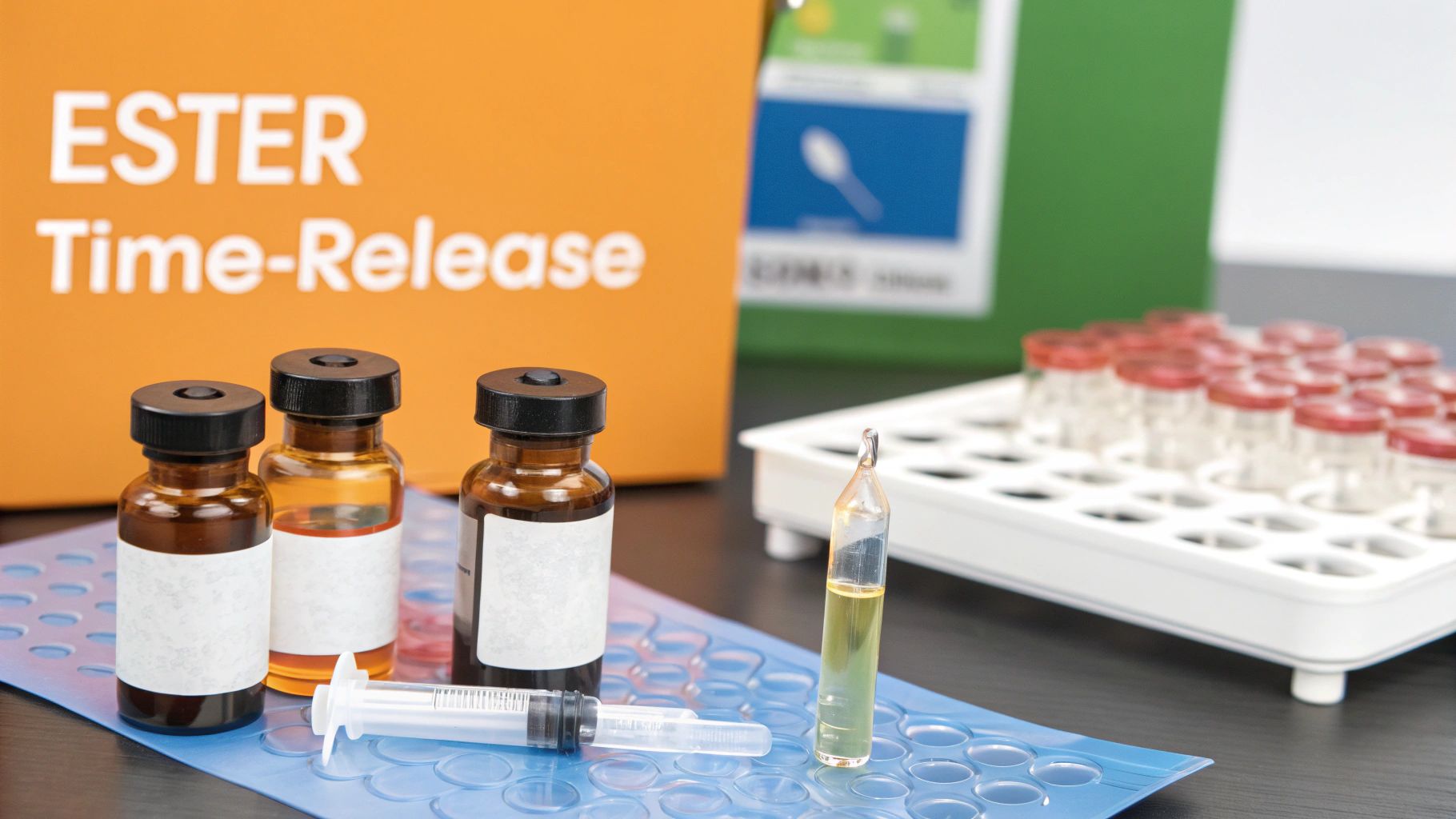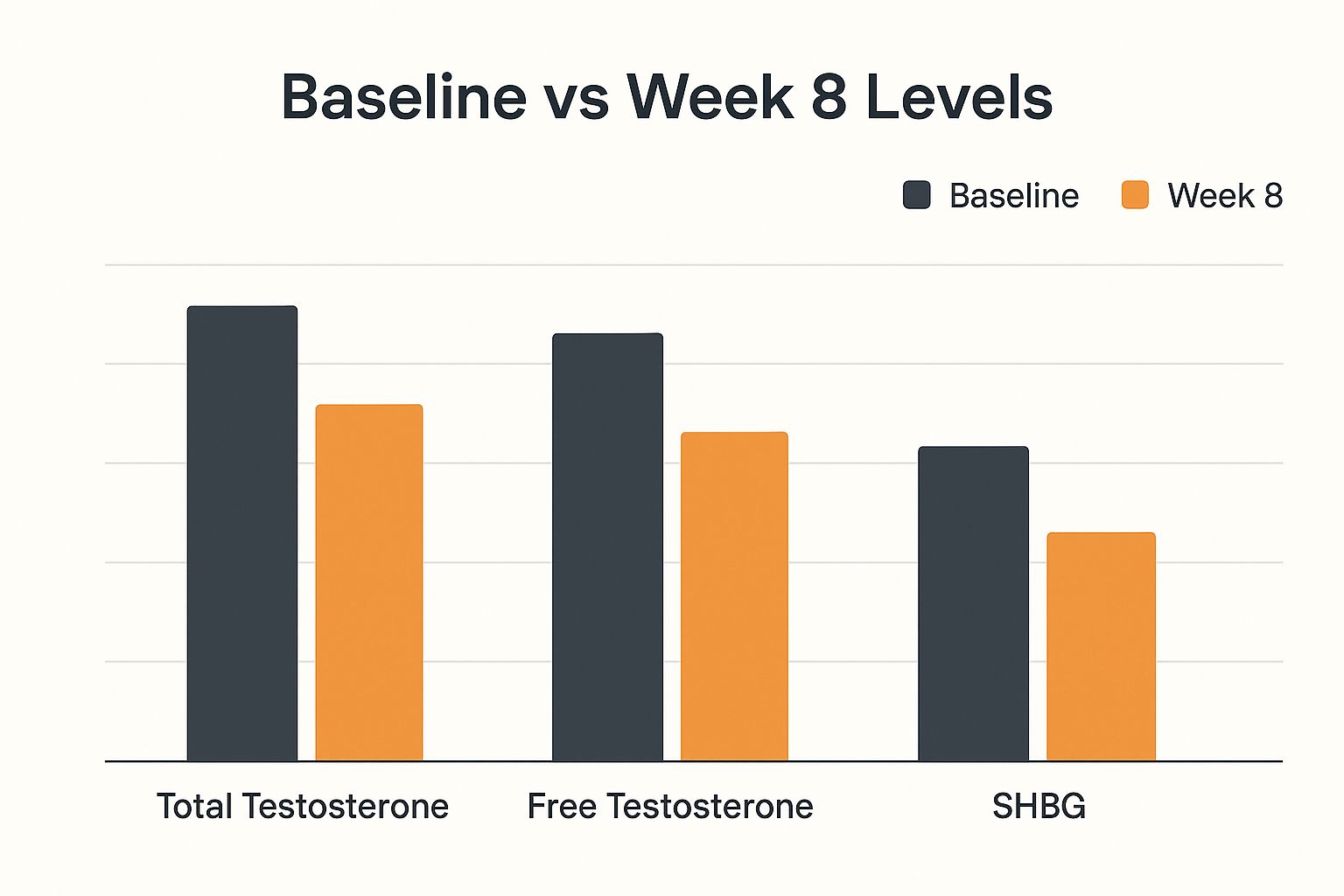Finding Your Ideal TRT Dosage Per Week

A common starting TRT dosage is between 80-125mg per week, but it’s critical to understand that this is just a starting point, not a final destination. Think of it like a tailor's first measurement—it gets you in the right ballpark, but the real magic is in the adjustments that follow. This initial dose is a carefully calculated estimate based on your unique health profile.
Understanding Your Starting TRT Dosage

There is no universal TRT dosage that works for everyone. Your treatment plan is like a prescription key, uniquely cut to fit your body’s specific lock. A dose that brings one man to his optimal range might be way too high or too low for another. This is precisely why a standardized, one-size-fits-all approach just doesn't work for hormone optimization.
Your journey begins with a comprehensive evaluation where a clinician analyzes several key factors to determine a safe and effective starting point. This initial dosage is a conservative estimate, designed to gently raise your testosterone levels while keeping potential side effects to a minimum.
Factors That Determine Your Initial Dose
A physician considers multiple variables before writing your first prescription. This personalized assessment ensures the protocol is aligned with your body's needs right from day one.
Key considerations include:
- Baseline Testosterone Levels: Your initial bloodwork reveals exactly how low your current levels are, giving doctors a clear picture of the deficit they need to address. Understanding average testosterone levels by age provides crucial context for setting your personal goals.
- Symptom Severity: The intensity of your symptoms—like fatigue, low libido, or brain fog—helps guide the initial dosing strategy. More severe symptoms might call for a slightly more robust starting dose.
- Overall Health and Body Composition: Factors like your age, body weight, and metabolism all influence how your body will absorb and use testosterone, demanding a truly individualized approach.
The primary goal of a starting dose isn't to achieve perfection immediately. It's to establish a safe baseline from which to make precise, data-driven adjustments over time.
This careful, methodical process ensures that your body adapts smoothly to the therapy. Subsequent blood tests and your own feedback on how you're feeling will guide any necessary tweaks down the road. This partnership between you and your provider is essential for dialing in the weekly TRT dosage that helps you feel your best while maintaining long-term health. It's a journey of fine-tuning, not a one-time fix.
How Different Testosterone Esters Affect Your Dose

Not all testosterone is created equal, and this is one of the first things you need to get your head around when starting TRT. When you get a prescription, it’s for a specific type of testosterone, usually Testosterone Cypionate or Testosterone Enanthate. The real difference between them is the attached "ester"—a chemical tail that controls how quickly the hormone gets into your system.
Think of the ester like the waxy coating on a time-release medicine capsule. A short ester tail dissolves fast, releasing the testosterone in a quick rush. A longer ester tail takes its time breaking down, leading to a much slower, more sustained release into your bloodstream.
This release speed is everything. It directly shapes both your ideal TRT dosage per week and how often you need to inject. A faster-acting testosterone would mean more frequent injections to keep your levels from crashing, while a longer-acting one lets you get away with fewer jabs. This is exactly why a 100 mg dose of one type of testosterone isn't the same as 100 mg of another in terms of how it feels and works over a week.
Understanding Common TRT Esters
The two esters you'll see most often in TRT protocols are almost twins, but they have tiny differences in their chemical structure and "half-life"—the time it takes for half of the dose to be processed and eliminated by your body.
- Testosterone Cypionate: This is a long-acting ester and the go-to choice in the United States. Its slow, steady release is perfect for weekly or even twice-weekly injections. This schedule helps maintain stable hormone levels and keeps you off the hormonal rollercoaster of sharp peaks and deep valleys.
- Testosterone Enanthate: Functionally, this is nearly identical to Cypionate and is another long-acting ester that’s popular across the globe. It also provides a steady release, allowing for a consistent weekly dosing schedule that minimizes those disruptive hormonal swings.
Why Dosing Schedules Have Evolved
If you look back, old-school protocols for long esters like Cypionate often involved huge, infrequent doses—think 200 mg every two weeks. The problem was, this created a brutal rollercoaster effect. Guys would feel superhuman right after the injection from supraphysiological peaks, only to crash hard with low levels just before the next dose was due. It was a recipe for wild mood and energy swings.
To fix this, modern TRT has shifted dramatically. Today’s protocols are all about mimicking the body's natural rhythm with smaller, more frequent doses, like 100 mg every week. This approach maintains far more stable and effective testosterone levels. You can learn more about these modern TRT dosing strategies and how they improve a patient's quality of life.
The goal of a well-designed TRT protocol is stability. By choosing the right ester and injection frequency, your clinician can create a smooth hormonal environment, helping you feel your best consistently without the disruptive highs and lows of outdated methods.
The Art and Science of Adjusting Your Weekly Dose
Your starting TRT dosage per week isn't the final word on your treatment. Far from it. Think of it as the opening line in a conversation between you, your body, and your doctor.
It’s like tuning a high-performance engine. You start with a standard setting, but the real magic happens when you get on the road and make tiny, precise adjustments based on performance data.
This fine-tuning is a blend of hard science and your personal experience. After you start therapy, follow-up bloodwork becomes your most important tool. It gives your clinician the hard data needed to see exactly how your body is responding to the initial dose.
But numbers on a lab report only tell half the story. The other, equally crucial half is how you feel. Are you actually noticing improvements in your energy, mood, and libido? Your feedback provides the context that makes the lab results meaningful.
Interpreting Your Bloodwork and Symptoms
Clinicians look at several key markers to guide dosage adjustments. It's not just about hitting a specific number for Total Testosterone; it's about creating total hormonal balance. The goal is to get your levels into the sweet spot while making sure other related hormones stay in a healthy range.
Key markers we always monitor include:
- Total and Free Testosterone: This is the most direct measure of success. It shows if the current dose is bringing your levels into the optimal therapeutic range.
- SHBG (Sex Hormone-Binding Globulin): This protein acts like a sponge, binding to testosterone and making it unusable. If your SHBG is high, you might need a higher dose or more frequent injections to increase the amount of "free" testosterone that actually does the work.
- Estradiol (E2): As testosterone levels climb, some of it naturally converts to estrogen. We keep a close eye on E2 to prevent side effects like water retention or moodiness, which can be a sign that your dose is a bit too high.
The perfect TRT dose is one where your lab values are optimized and your symptoms are resolved. It's a dual-target approach that requires both scientific analysis and attentive listening to your body's signals.
This chart gives you a clear look at the typical progress you can expect to see in these key markers after about eight weeks of therapy.

As you can see, both Total and Free Testosterone levels increase significantly. Meanwhile, SHBG often adjusts in response, clearly showing the therapy's direct impact on your system.
Making Data-Driven Adjustments
Armed with this combined feedback—your labs and how you feel—your doctor will make strategic changes.
For example, let's say your Free Testosterone is still low even though your Total Testosterone looks good. This often points to high SHBG. The solution might be to increase your injection frequency, which helps maintain higher levels of unbound, active testosterone.
On the other hand, if you report feeling anxious and your estradiol comes back high, your doctor may slightly lower your weekly dose to dial back that estrogen conversion. Each adjustment is a calculated step toward finding your unique hormonal equilibrium.
Learning how to read lab results can empower you to better understand these decisions and become an active partner in your own health journey. This cycle of testing, feeling, and adjusting is the absolute core of successful, long-term TRT.
Why Injection Frequency Matters as Much as Dosage
Figuring out your total TRT dosage per week is only half the story. The other, equally critical half is how often you inject. The frequency of your injections plays a massive role in how you feel day-to-day, the stability of your hormone levels, and the side effects you might experience.
Think of it like watering a plant. You wouldn't give it a month's worth of water all at once; you'd drown it and then it would dry out. Instead, you provide smaller, consistent amounts over time. Your body’s endocrine system works much the same way—it thrives on stability, not massive, infrequent floods of hormones.
Outdated TRT protocols often prescribed huge injections every two, three, or even four weeks. This created a brutal hormonal rollercoaster: a massive, supraphysiological peak right after the shot, followed by a long, slow decline into a trough where low-T symptoms would return with a vengeance.

The Modern Approach: Stability Is The Goal
Modern TRT has thankfully moved away from this volatile model. The goal now is to mimic the body's natural, steady testosterone production. The key to achieving this is through more frequent, smaller injections. This approach flattens out those dramatic peaks and troughs, leading to a much smoother and more effective experience.
The most common and effective schedules today involve injections once or, more ideally, twice per week.
- Once-Weekly Injections: Administering your full weekly dose on a single day is a huge improvement over those old bi-weekly shots, creating a far more stable baseline.
- Twice-Weekly Injections: Splitting your total weekly dose into two smaller injections (say, on Monday and Thursday) is now widely considered the gold standard. This schedule creates remarkably stable blood serum levels, closely replicating natural hormonal rhythms.
By dividing the total weekly dose, you create a far more stable hormonal environment. This is crucial because it significantly reduces the conversion of testosterone into estrogen—a primary driver of side effects like bloating, mood swings, and gynecomastia.
Comparing TRT Injection Frequencies
Choosing an injection schedule is a critical decision that directly impacts how you'll feel on TRT. While less frequent injections might seem more convenient, they often come at the cost of hormonal stability. The table below breaks down the pros and cons of the most common approaches, showing why more frequent, smaller doses are now the preferred method.
| Frequency | Pros | Cons |
|---|---|---|
| Every 2-4 Weeks | – Very few injections, seems convenient. – Old-school method, some doctors still use it. |
– Creates extreme hormonal peaks and troughs. – High risk of estrogen-related side effects. – Symptoms often return long before the next shot. |
| Once Weekly | – Good balance of convenience and stability. – Drastically reduces peaks and troughs compared to older methods. – Easy to remember and manage. |
– Still has a noticeable peak and trough for sensitive individuals. – Higher potential for estrogen conversion than twice-weekly. |
| Twice Weekly | – Considered the gold standard for stability. – Closely mimics the body’s natural testosterone rhythm. – Minimizes estrogen conversion and side effects. – Provides a very consistent sense of well-being. |
– Requires more frequent injections. – Can be intimidating for new users. |
| Every Other Day (EOD) | – Offers exceptional hormonal stability. – Further reduces estrogen conversion. – Preferred by some for very precise control. |
– High injection frequency can be a hassle. – More potential for injection site irritation. – Often unnecessary unless you are highly sensitive. |
Ultimately, the goal is to find the frequency that keeps your hormone levels as steady as possible, minimizing side effects and maximizing benefits. For most men, a twice-weekly schedule strikes the perfect balance.
How Frequency Impacts Side Effects
The link between how often you inject and the side effects you experience is direct. When you inject a large amount of testosterone at once, your body responds to the sudden spike by ramping up the aromatase enzyme, which converts testosterone to estradiol (estrogen). This spike in estrogen is what causes many of TRT's most avoidable side effects.
More frequent, smaller injections keep testosterone levels from spiking too high. This results in less aromatization and, consequently, more stable estrogen levels. It’s no surprise that patients on a twice-weekly schedule often report fewer side effects and a much more consistent sense of well-being.
Getting comfortable with the process is key. Our guide on how to perform a painless testosterone self-injection can help you master the technique with confidence. In the end, a well-planned injection frequency ensures your weekly TRT dosage works for you, not against you.
Special Dosing Considerations You Should Know
While most of the TRT conversation revolves around adult men, it's a huge mistake to think of this therapy as a one-size-fits-all solution. Certain groups need a completely different, highly specialized approach where standard male protocols would be more than just wrong—they could be genuinely harmful.
Fine-tuning the TRT dosage per week for these individuals isn't about small tweaks; it's a delicate process that absolutely requires an expert hand. Two groups in particular—women and older men—have unique physiological needs that completely change the game.
TRT Protocols for Women
Yes, testosterone is a vital hormone for women, too. It plays a massive role in libido, energy levels, and an overall sense of well-being. But when it's prescribed for issues like Hypoactive Sexual Desire Disorder (HSDD), the goal is worlds apart from male TRT. The objective is to restore levels to a healthy female physiological range, not a male one.
This means the dosages are incredibly small.
- Fractional Dosing: Women usually need just a fraction of a standard male dose—often only 5-10% of what a man would take.
- Careful Monitoring: The risk of virilization (developing masculine features) is real, so clinicians have to monitor patients very closely for any unwanted side effects.
- Expert Guidance is Non-Negotiable: Self-prescribing is extremely dangerous for women and can lead to side effects that are permanent.
The medical community remains cautious with female testosterone therapy, mostly because long-term safety data is still limited and there aren't many female-specific products available. The current strategy involves using low doses to bring blood concentrations in line with those of healthy premenopausal women—about one-tenth of male doses. It's primarily used for HSDD after a doctor has thoroughly ruled out any other causes. You can get more insights from the female testosterone therapy guidelines at NCBI.
Adjusting Dosages for Older Men
As men get older, their bodies often become more sensitive to hormonal shifts. While low T is common in this group, jumping into TRT requires a much more conservative game plan. Things like a slower metabolism, other health conditions, and potential interactions with other medications all have to be factored in.
For older patients, the philosophy is almost always "start low and go slow." A lower initial dose lets the clinician see how the body responds and minimizes the risk of side effects like a spike in hematocrit or prostate issues.
For example, a starting dose might be closer to 50-75 mg per week instead of the typical 100 mg. This cautious method ensures the benefits of therapy are achieved without putting extra stress on the cardiovascular system or other organs. For this group, regular bloodwork and frequent symptom check-ins are even more critical to make sure the treatment stays both safe and effective for the long haul.
Common Questions About Your Weekly TRT Dosage
As you get started with TRT, it's completely normal for practical questions to pop up. Getting clear answers is what helps you stay confident and on track with your therapy, making sure you get the best possible results from your weekly TRT dosage. Let's tackle some of the most common concerns guys have.
This field is always moving forward. We're seeing a huge upward trend in testosterone replacement therapy use across the globe, and dosage strategies are evolving right along with it. For instance, a study in Belgium between 2013 and 2022 saw the number of doses for Sustanon®, a popular testosterone blend, jump by 101%. At the same time, testosterone testing increased by 42%, showing just how much clinical awareness of low T has grown. You can dive deeper into these trends in testosterone therapy prescription on endocrine-abstracts.org.
What Should I Do If I Miss a Dose?
First off, don't panic. Missing a dose isn't a catastrophe, but how you handle it depends on when you remember. The golden rule is to never double up, as that can cause a sharp, unnecessary spike in your hormone levels.
- If you remember within a day or two: Go ahead and take your missed dose as soon as you can. Then, just get back to your regular schedule. If your next shot is right around the corner, though, it's better to just skip the one you missed.
- If it's almost time for your next shot: Just skip the missed dose entirely and take your next one as planned. Whatever you do, don't take two doses close together.
Consistency is the goal here, not perfection. A single missed injection is very unlikely to cause a major setback or bring back your symptoms. Just get back on track with your next scheduled dose.
How Do I Know If My Dose Is Too High or Too Low?
Your body is great at giving you feedback, and it will send clear signals if your dose isn't dialed in just right. Learning to recognize these signs is a crucial part of working with your doctor to fine-tune your protocol.
Signs Your Dose May Be Too High:
- Feeling more anxious, irritable, or having mood swings.
- Noticing water retention, puffiness, or bloating.
- Breaking out with acne, especially on your back or shoulders.
- Developing oily skin or seeing your blood pressure creep up.
Signs Your Dose May Be Too Low:
- Your old low T symptoms start creeping back (like fatigue and brain fog).
- Your libido or energy levels aren't really improving.
- You’re struggling to build or hold onto muscle.
- A general low mood or lack of motivation sticks around.
How you feel is just as important as your lab results. If your numbers look great on paper but you still don't feel right, you have to communicate that to your provider. The goal is to resolve your symptoms, not just to hit a specific number on a lab report.
How Long Until I Feel a New Dose Adjustment?
It's natural to be eager for results after your doctor adjusts your TRT dosage per week. But patience is a virtue here, because real physiological changes take time. Your body needs a chance to settle in and adapt to the new hormonal levels.
Generally, it takes about 4 to 6 weeks for your blood levels to fully stabilize after a dosage change. During this window, you’ll likely start noticing subtle shifts in your energy, mood, and overall sense of well-being. This is precisely why follow-up bloodwork is usually scheduled for that timeframe—it gives an accurate picture of how your body has responded, allowing for any further data-driven tweaks if needed.
At Elite Bioscience, we believe optimizing your hormones is a partnership. Our experts are with you at every step, making sure your treatment is perfectly calibrated to what your body needs. Take control of your health journey with our tailored TRT programs today.
QUICK SEARCH
Make an account today to start your journey towards a better and healthier lifestyle.






